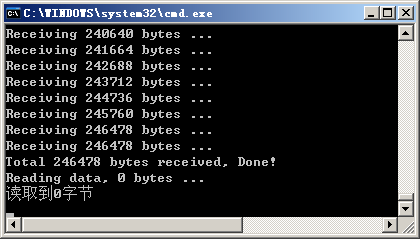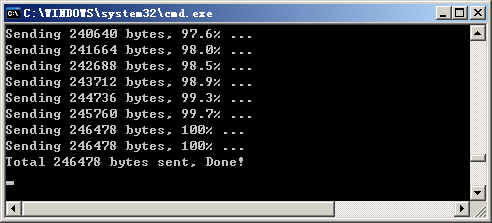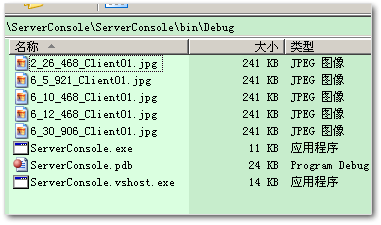文件傳輸
前面兩篇文章所使用的范例都是傳輸字符串,有的時候我們可能會想在服務端和客戶端之間傳遞文件 。比如,考慮這樣一種情況,假如客戶端顯示了一個菜單,當我們輸入S1、S2或S3(S為Send縮寫)時, 分別向服務端發送文件Client01.jpg、Client02.jpg、Client03.jpg;當我們輸入R1、R2或R3時(R為 Receive縮寫),則分別從服務端接收文件Server01.jpg、Server02.jpg、Server03.jpg。那麼,我們該 如何完成這件事呢?此時可能有這樣兩種做法:
類似於FTP協議,服務端開辟兩個端口,並持續對這兩個端口偵聽:一個用於接收字符串,類似於FTP 的控制端口,它接收各種命令(接收或發送文件);一個用於傳輸數據,也就是發送和接收文件。
服務端只開辟一個端口,用於接收字符串,我們稱之為控制端口。當接到請求之後,根據請求內容在 客戶端開辟一個端口專用於文件傳輸,並在傳輸結束後關閉端口。
現在我們只關注於上面的數據端口,回憶一下在第二篇中我們所總結的,可以得出:當我們使用上面 的方法一時,服務端的數據端口可以為多個客戶端的多次請求服務;當我們使用方法二時,服務端只為一 個客戶端的一次請求服務,但是因為每次請求都會重新開辟端口,所以實際上還是相當於可以為多個客戶 端的多次請求服務。同時,因為它只為一次請求服務,所以我們在數據端口上傳輸文件時無需采用異步傳 輸方式。但在控制端口我們仍然需要使用異步方式。
從上面看出,第一種方式要好得多,但是我們將采用第二種方式。至於原因,你可以回顧一下Part.1 (基本概念和操作)中關於聊天程序模式的講述,因為接下來一篇文章我們將創建一個聊天程序,而這個 聊天程序采用第三種模式,所以本文的練習實際是對下一篇的一個鋪墊。
1.訂立協議
1.1發送文件
我們先看一下發送文件的情況,如果我們想將文件client01.jpg由客戶端發往客戶端,那麼流程是什 麼:
客戶端開辟數據端口用於偵聽,並獲取端口號,假設為8005。
假設客戶端輸入了S1,則發送下面的控制字符串到服務端:[file=Client01.jpg, mode=send, port=8005]。
服務端收到以後,根據客戶端ip和端口號與該客戶端建立連接。
客戶端偵聽到服務端的連接,開始發送文件。
傳送完畢後客戶端、服務端分別關閉連接。
此時,我們訂立的發送文件協議為:[file=Client01.jpg, mode=send, port=8005]。但是,由於它是 一個普通的字符串,在上一篇中,我們采用了正則表達式來獲取其中的有效值,但這顯然不是一種好辦法 。因此,在本文及下一篇文章中,我們采用一種新的方式來編寫協議:XML。對於上面的語句,我們可以 寫成這樣的XML:
<protocol><file name="client01.jpg" mode="send" port="8005" /></protocol>
這樣我們在服務端就會好處理得多,接下來我們來看一下接收文件的流程及其協議。
NOTE:這裡說發送、接收文件是站在客戶端的立場說的,當客戶端發送文件時,對於服務器來收,則 是接收文件。
1.2接收文件
接收文件與發送文件實際上完全類似,區別只是由客戶端向網絡流寫入數據,還是由服務端向網絡流 寫入數據。
客戶端開辟數據端口用於偵聽,假設為8006。
假設客戶端輸入了R1,則發送控制字符串:<protocol><file name="Server01.jpg" mode="receive" port="8006" /></protocol>到服務端。
服務端收到以後,根據客戶端ip和端口號與該客戶端建立連接。
客戶端建立起與服務端的連接,服務端開始網絡流中寫入數據。
傳送完畢後服務端、客戶端分別關閉連接。
2.協議處理類的實現
和上面一章一樣,在開始編寫實際的服務端客戶端代碼之前,我們首先要編寫處理協議的類,它需要 提供這樣兩個功能:1、方便地幫我們獲取完整的協議信息,因為前面我們說過,服務端可能將客戶端的 多次獨立請求拆分或合並。比如,客戶端連續發送了兩條控制信息到服務端,而服務端將它們合並了,那 麼則需要先拆開再分別處理。2、方便地獲取我們所想要的屬性信息,因為協議是XML格式,所以還需要一 個類專門對XML進行處理,獲得字符串的屬性值。
2.1 ProtocalHandler輔助類
我們先看下ProtocalHandler,它與上一篇中的RequestHandler作用相同。需要注意的是必須將它聲明 為實例的,而非靜態的,這是因為每個TcpClient都需要對應一個ProtocalHandler,因為它內部維護的 patialProtocal不能共享,在協議發送不完整的情況下,這個變量用於臨時保存被截斷的字符串。
public class ProtocolHandler {
private string partialProtocal; // 保存不完整的協議
public ProtocolHandler() {
partialProtocal = "";
}
public string[] GetProtocol(string input) {
return GetProtocol(input, null);
}
// 獲得協議
private string[] GetProtocol(string input, List<string> outputList) {
if (outputList == null)
outputList = new List<string>();
if (String.IsNullOrEmpty(input))
return outputList.ToArray();
if (!String.IsNullOrEmpty(partialProtocal))
input = partialProtocal + input;
string pattern = "(^<protocol>.*?</protocol>)";
// 如果有匹配,說明已經找到了,是完整的協議
if (Regex.IsMatch(input, pattern)) {
// 獲取匹配的值
string match = Regex.Match(input, pattern).Groups[0].Value;
outputList.Add(match);
partialProtocal = "";
// 縮短input的長度
input = input.Substring(match.Length);
// 遞歸調用
GetProtocol(input, outputList);
} else {
// 如果不匹配,說明協議的長度不夠,
// 那麼先緩存,然後等待下一次請求
partialProtocal = input;
}
return outputList.ToArray();
}
}
因為現在它已經不是本文的重點了,所以我就不演示對於它的測試了,本文所附帶的代碼中含有它的 測試代碼(我在ProtocolHandler中添加了一個靜態類Test())。
2.2 FileRequestType枚舉和FileProtocol結構
因為XML是以字符串的形式在進行傳輸,為了方便使用,我們最好構建一個強類型來對它們進行操作, 這樣會方便很多。我們首先可以定義FileRequestMode枚舉,它代表是發送還是接收文件:
public enum FileRequestMode {
Send = 0,
Receive
}
接下來我們再定義一個FileProtocol結構,用來為整個協議字符串提供強類型的訪問,注意這裡覆蓋 了基類的ToString()方法,這樣在客戶端我們就不需要再手工去編寫XML,只要在結構值上調用ToString ()就OK了,會方便很多。
public struct FileProtocol {
private readonly FileRequestMode mode;
private readonly int port;
private readonly string fileName;
public FileProtocol
(FileRequestMode mode, int port, string fileName) {
this.mode = mode;
this.port = port;
this.fileName = fileName;
}
public FileRequestMode Mode {
get { return mode; }
}
public
int
Port {
get { return port; }
}
public string FileName {
get { return fileName; }
}
public override string ToString() {
return String.Format("<protocol><file name=\"{0}\" mode=\"{1}\" port=\"{2}\" /></protocol>", fileName, mode, port);
}
}
2.3 ProtocolHelper輔助類
這個類專用於將XML格式的協議映射為我們上面定義的強類型對象,這裡我沒有加入try/catch異常處 理,因為協議對用戶來說是不可見的,而且客戶端應該總是發送正確的協議,我覺得這樣可以讓代碼更加 清晰:
public class ProtocolHelper {
private XmlNode fileNode;
private XmlNode root;
public ProtocolHelper(string protocol) {
XmlDocument doc = new XmlDocument();
doc.LoadXml(protocol);
root = doc.DocumentElement;
fileNode = root.SelectSingleNode("file");
}
// 此時的protocal一定為單條完整protocal
private FileRequestMode GetFileMode() {
string mode = fileNode.Attributes["mode"].Value;
mode = mode.ToLower();
if (mode == "send")
return FileRequestMode.Send;
else
return FileRequestMode.Receive;
}
// 獲取單條協議包含的信息
public FileProtocol GetProtocol() {
FileRequestMode mode = GetFileMode();
string fileName = "";
int port = 0;
fileName = fileNode.Attributes["name"].Value;
port = Convert.ToInt32(fileNode.Attributes["port"].Value);
return new FileProtocol(mode, port, fileName);
}
}
OK,我們又耽誤了點時間,下面就讓我們進入正題吧。
3.客戶端發送數據
3.1 服務端的實現
我們還是將一個問題分成兩部分來處理,先是發送數據,然後是接收數據。我們先看發送數據部分的 服務端。如果你從第一篇文章看到了現在,那麼我覺得更多的不是技術上的問題而是思路,所以我們不再 將重點放到代碼上,這些應該很容易就看懂了。
class Server {
static void
Main(string[] args) {
Console.WriteLine("Server is running ... ");
IPAddress ip = IPAddress.Parse("127.0.0.1");
TcpListener listener = new TcpListener(ip, 8500);
listener.Start(); // 開啟對控制端口 8500 的偵聽
Console.WriteLine("Start Listening ...");
while (true) {
// 獲取一個連接,同步方法,在此處中斷
TcpClient client = listener.AcceptTcpClient();
RemoteClient wapper = new RemoteClient(client);
wapper.BeginRead();
}
}
}
public class RemoteClient {
private TcpClient client;
private NetworkStream streamToClient;
private const int BufferSize = 8192;
private byte[] buffer;
private ProtocolHandler handler;
public RemoteClient(TcpClient client) {
this.client = client;
// 打印連接到的客戶端信息
Console.WriteLine("\nClient Connected!{0} <-- {1}",
client.Client.LocalEndPoint, client.Client.RemoteEndPoint);
// 獲得流
streamToClient = client.GetStream();
buffer = new byte[BufferSize];
handler = new ProtocolHandler();
}
// 開始進行讀取
public void BeginRead() {
AsyncCallback callBack = new AsyncCallback(OnReadComplete);
streamToClient.BeginRead(buffer, 0, BufferSize, callBack, null);
}
// 再讀取完成時進行回調
private void OnReadComplete(IAsyncResult ar) {
int bytesRead = 0;
try {
lock (streamToClient) {
bytesRead = streamToClient.EndRead(ar);
Console.WriteLine("
Reading data, {0} bytes ...", bytesRead);
}
if (bytesRead == 0) throw new Exception("讀取到0字節");
string msg = Encoding.Unicode.GetString(buffer, 0, bytesRead);
Array.Clear(buffer,0,buffer.Length); // 清空緩存,避 免髒讀
// 獲取protocol數組
string[] protocolArray = handler.GetProtocol(msg);
foreach (string pro in protocolArray) {
// 這裡異步調用,不然這裡可能會比較耗時
ParameterizedThreadStart start =
new ParameterizedThreadStart(handleProtocol);
start.BeginInvoke(pro, null, null);
}
// 再次調用BeginRead(),完成時調用自身,形成無限循環
lock (streamToClient) {
AsyncCallback callBack = new AsyncCallback (OnReadComplete);
streamToClient.BeginRead(buffer, 0, BufferSize, callBack, null);
}
} catch(Exception ex) {
if(streamToClient!=null)
streamToClient.Dispose();
client.Close();
Console.WriteLine(ex.Message); // 捕獲異常時退出程序
}
}
// 處理protocol
private void handleProtocol(object obj) {
string pro = obj as string;
ProtocolHelper helper = new ProtocolHelper(pro);
FileProtocol protocol = helper.GetProtocol();
if (protocol.Mode == FileRequestMode.Send) {
// 客戶端發送文件,對服務端來說則是接收文件
receiveFile(protocol);
} else if (protocol.Mode == FileRequestMode.Receive) {
// 客戶端接收文件,對服務端來說則是發送文件
// sendFile(protocol);
}
}
private void receiveFile(FileProtocol protocol) {
// 獲取遠程客戶端的位置
IPEndPoint endpoint = client.Client.RemoteEndPoint as IPEndPoint;
IPAddress ip = endpoint.Address;
// 使用新端口號,獲得遠程用於接收文件的端口
endpoint = new IPEndPoint(ip, protocol.Port);
// 連接到遠程客戶端
TcpClient localClient;
try {
localClient = new TcpClient();
localClient.Connect(endpoint);
} catch {
Console.WriteLine("無法連接到客戶端 --> {0}", endpoint);
return;
}
// 獲取發送文件的流
NetworkStream streamToClient = localClient.GetStream();
// 隨機生成一個在當前目錄下的文件名稱
string path =
Environment.CurrentDirectory + "/" + generateFileName (protocol.FileName);
byte[] fileBuffer = new byte[1024]; // 每次收1KB
FileStream fs = new FileStream(path, FileMode.CreateNew, FileAccess.Write);
// 從緩存buffer中讀入到文件流中
int bytesRead;
int totalBytes = 0;
do {
bytesRead = streamToClient.Read(buffer, 0, BufferSize);
fs.Write(buffer, 0, bytesRead);
totalBytes += bytesRead;
Console.WriteLine("Receiving {0} bytes ...", totalBytes);
} while (bytesRead > 0);
Console.WriteLine("Total {0} bytes received, Done!", totalBytes);
streamToClient.Dispose();
fs.Dispose();
localClient.Close();
}
// 隨機獲取一個圖片名稱
private string generateFileName(string fileName) {
DateTime now = DateTime.Now;
return String.Format(
"{0}_{1}_{2}_{3}", now.Minute, now.Second, now.Millisecond, fileName
);
}
}
這裡應該沒有什麼新知識,需要注意的地方有這麼幾個:
在OnReadComplete()回調方法中的foreach循環,我們使用委托異步調用了handleProtocol()方法,這 是因為handleProtocol即將執行的是一個讀取或接收文件的操作,也就是一個相對耗時的操作。
在handleProtocol()方法中,我們深切體會了定義ProtocolHelper類和FileProtocol結構的好處。如 果沒有定義它們,這裡將是不堪入目的處理XML以及類型轉換的代碼。
handleProtocol()方法中進行了一個條件判斷,注意sendFile()方法我屏蔽掉了,這個還沒有實現, 但是我想你已經猜到它將是後面要實現的內容。
receiveFile()方法是實際接收客戶端發來文件的方法,這裡沒有什麼特別之處。需要注意的是文件存 儲的路徑,它保存在了當前程序執行的目錄下,文件的名稱我使用generateFileName()生成了一個與時間 有關的隨機名稱。
3.2客戶端的實現
我們現在先不著急實現客戶端S1、R1等用戶菜單,首先完成發送文件這一功能,實際上,就是為上一 節SendMessage()加一個姐妹方法SendFile()。
class Client {
static void
Main(string[] args) {
ConsoleKey key;
ServerClient client = new ServerClient();
string filePath = Environment.CurrentDirectory + "/" + "Client01.jpg";
if(File.Exists(filePath))
client.BeginSendFile(filePath);
Console.WriteLine("\n\n輸入\"Q\"鍵退出。");
do {
key = Console.ReadKey(true).Key;
} while (key != ConsoleKey.Q);
}
}
public class ServerClient {
private const int BufferSize = 8192;
private byte[] buffer;
private TcpClient client;
private NetworkStream streamToServer;
public ServerClient() {
try {
client = new TcpClient();
client.Connect("localhost", 8500); // 與服務器連接
} catch (Exception ex) {
Console.WriteLine(ex.Message);
return;
}
buffer = new byte[BufferSize];
// 打印連接到的服務端信息
Console.WriteLine("Server Connected!{0} --> {1}",
client.Client.LocalEndPoint, client.Client.RemoteEndPoint);
streamToServer = client.GetStream();
}
// 發送消息到服務端
public void SendMessage(string msg) {
byte[] temp = Encoding.Unicode.GetBytes(msg); // 獲得緩存
try {
lock (streamToServer) {
streamToServer.Write(temp, 0, temp.Length); // 發往服務器
}
Console.WriteLine("Sent: {0}", msg);
} catch (Exception ex) {
Console.WriteLine(ex.Message);
return;
}
}
// 發送文件 - 異步方法
public void BeginSendFile(string filePath) {
ParameterizedThreadStart start =
new ParameterizedThreadStart(BeginSendFile);
start.BeginInvoke(filePath, null, null);
}
private void BeginSendFile(object obj) {
string filePath = obj as string;
SendFile(filePath);
}
// 發送文件 -- 同步方法
public void SendFile(string filePath) {
IPAddress ip = IPAddress.Parse("127.0.0.1");
TcpListener listener = new TcpListener(ip, 0);
listener.Start();
// 獲取本地偵聽的端口號
IPEndPoint endPoint = listener.LocalEndpoint as IPEndPoint;
int listeningPort = endPoint.Port;
// 獲取發送的協議字符串
string fileName = Path.GetFileName(filePath);
FileProtocol protocol =
new FileProtocol(FileRequestMode.Send, listeningPort, fileName);
string pro = protocol.ToString();
SendMessage(pro); // 發送協議到服務端
// 中斷,等待遠程連接
TcpClient localClient = listener.AcceptTcpClient();
Console.WriteLine("Start sending file...");
NetworkStream stream = localClient.GetStream();
// 創建文件流
FileStream fs = new FileStream(filePath, FileMode.Open, FileAccess.Read);
byte[] fileBuffer = new byte[1024]; // 每次傳1KB
int bytesRead;
int totalBytes = 0;
// 創建獲取文件發送狀態的類
SendStatus status = new SendStatus(filePath);
// 將文件流轉寫入網絡流
try {
do {
Thread.Sleep(10); // 為了更好的視覺效果 ,暫停10毫秒:-)
bytesRead = fs.Read(fileBuffer, 0, fileBuffer.Length);
stream.Write(fileBuffer, 0, bytesRead);
totalBytes += bytesRead; // 發送了的 字節數
status.PrintStatus(totalBytes); // 打印發送狀態
} while (bytesRead > 0);
Console.WriteLine("Total {0} bytes sent, Done!", totalBytes);
} catch {
Console.WriteLine("Server has lost...");
}
stream.Dispose();
fs.Dispose();
localClient.Close();
listener.Stop();
}
}
接下來我們來看下這段代碼,有這麼兩點需要注意一下:
在Main()方法中可以看到,圖片的位置為應用程序所在的目錄,如果你跟我一樣處於調試模式,那麼 就在解決方案的Bin目錄下的Debug目錄中放置三張圖片Client01.jpg、Client02.jpg、Client03.jpg,用 來發往服務端。
我在客戶端提供了兩個SendFile()方法,和一個BeginSendFile()方法,分別用於同步和異步傳輸,其 中私有的SendFile()方法只是一個輔助方法。實際上對於發送文件這樣的操作我們幾乎總是需要使用異步 操作。
SendMessage()方法中給streamToServer加鎖很重要,因為SendFile()方法是多線程訪問的,而在 SendFile()方法中又調用了SendMessage()方法。
我另外編寫了一個SendStatus類,它用來記錄和打印發送完成的狀態,已經發送了多少字節,完成度 是百分之多少,等等。本來這個類的內容我是直接寫入在Client類中的,後來我覺得它執行的工作已經不 屬於Client本身所應該執行的領域之內了,我記得這樣一句話:當你覺得類中的方法與類的名稱不符的時 候,那麼就應該考慮重新創建一個類。我覺得用在這裡非常恰當。
下面是SendStatus的內容:
// 即時計算發送文件的狀態
public class SendStatus {
private FileInfo info;
private long fileBytes;
public SendStatus(string filePath) {
info = new FileInfo(filePath);
fileBytes = info.Length;
}
public void PrintStatus(int sent) {
string percent = GetPercent(sent);
Console.WriteLine("Sending {0} bytes, {1}% ...", sent, percent);
}
// 獲得文件發送的百分比
public string GetPercent(int sent){
decimal allBytes = Convert.ToDecimal(fileBytes);
decimal currentSent = Convert.ToDecimal(sent);
decimal percent = (currentSent / allBytes) * 100;
percent = Math.Round(percent, 1); //保留一位小數
if (percent.ToString() == "100.0")
return "100";
else
return percent.ToString();
}
}
3.3程序測試
接下裡我們運行一下程序,來檢查一下輸出,首先看下服務端:

接著是客戶端,我們能夠看到發送的字節數和進度,可以想到如果是圖形界面,那麼我們可以通過擴 展SendStatus類來創建一個進度條:

最後我們看下服務端的Bin\Debug目錄,應該可以看到接收到的圖片:

本來我想這篇文章就可以完成發送和接收,不過現在看來沒法實現了,因為如果繼續下去這篇文章就 太長了,我正嘗試著盡量將文章控制在15頁以內。那麼我們將在下篇文章中再完成接收文件這一部分。
本文配套源碼